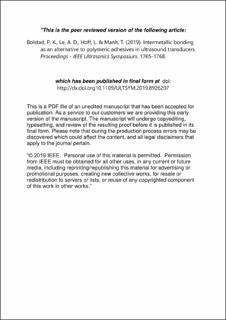| dc.contributor.author | Bolstad, Per Kristian | |
| dc.contributor.author | Le, Anh Duy | |
| dc.contributor.author | Hoff, Lars | |
| dc.contributor.author | Manh, Tung | |
| dc.date.accessioned | 2020-03-24T09:52:51Z | |
| dc.date.available | 2020-03-24T09:52:51Z | |
| dc.date.created | 2019-11-12T11:38:46Z | |
| dc.date.issued | 2019 | |
| dc.identifier.citation | Proceedings - IEEE Ultrasonics Symposium. 2019, 1765-1768. | en_US |
| dc.identifier.issn | 1948-5719 | |
| dc.identifier.uri | https://hdl.handle.net/11250/2648292 | |
| dc.description.abstract | Common ultrasound transducers utilize epoxy for bonding the active piezoelectric to the rest of the acoustic stack. This paper explores some of the potential benefits of replacing this soft epoxy layer with a harder metallurgical bond. The influence of varying the bond layer thickness was evaluated for epoxy- and intermetallic bonding layers in an ultrasound transducer, as was the effect of voids and delamination that may occur during fabrication of intermetallic bonds. It was found that the intermetallic bond could be made much thicker than an epoxy bond without degrading the transducer performance, and the influence by thickness variations was less. Small voids in the intermetallic where shown to cause a downshift in resonance frequency, whereas regions with delamination will cause reflections that degrade the performance of the transducer. | en_US |
| dc.language.iso | eng | en_US |
| dc.title | Intermetallic bonding as an alternative to polymeric adhesives in ultrasound transducers | en_US |
| dc.type | Peer reviewed | en_US |
| dc.type | Journal article | en_US |
| dc.description.version | acceptedVersion | en_US |
| dc.source.pagenumber | 1765-1768 | en_US |
| dc.source.journal | Proceedings - IEEE Ultrasonics Symposium | en_US |
| dc.identifier.doi | 10.1109/ULTSYM.2019.8926207 | |
| dc.identifier.cristin | 1746433 | |
| dc.relation.project | Norges forskningsråd: 245963 | en_US |
| dc.relation.project | Norges forskningsråd: 237887 | en_US |
| cristin.ispublished | true | |
| cristin.fulltext | postprint | |
| cristin.qualitycode | 1 | |
